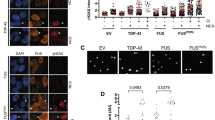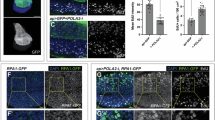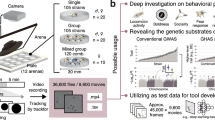Abstract
Ten lines of Drosophila simulans were investigated with respect to P activity, P susceptibility and the number and structure of their P copies, eight years after transformation with the P element. All 10 were found to have reached a steady state. They exhibited varying levels of P activity (from 0 per cent to 96 per cent GD sterility) and, with the exception of one line, were not P-susceptible. In contrast with P element behaviour in D. melanogaster: (i) no relationship was found between the molecular pattern of P copies in a line and its ability to induce or to repress P expression in D. simulans; (ii) peculiar P element derivatives were observed in this species; (iii) the average number of P copies per genome was only half of that in D. melanogaster. This may result from transposon–host genome interactions, which lead to a low invading power of the P element in D. simulans.
Similar content being viewed by others
Article PDF
References
Anxolabéhère, D, Nouaud, D, Périquet, G, and Tchen, P. 1985. P-element distribution in Eurasian populations of Drosophila melanogaster. A genetic and molecular analysis. Proc Natl Acad Sci USA, 82, 5418–5422.
Anxolabéhère, D, Kidwell, M G, and Périquet, G. 1988. Molecular characteristics of diverse populations are consistent with a recent invasion of Drosophila melanogaster by mobile P element. Mol Biol Evol, 5, 252–269.
Bingham, P M, Kidwell, M G, and Rubin, G M. 1982. The molecular basis of P-M hybrid dysgenesis: the role of the P element, a P-strain-specific transposon family. Cell, 29, 995–1004.
Black, D M, Jackson, M S, Kidwell, M G, and Dover, G A. 1987. KP elements repress P-induced hybrid dysgenesis in Drosophila melanogaster. EMBO J, 6, 4125–4135.
Brookfield, J F Y, Montgomery, E, and Langley, C H. 1984. Apparent absence of transposable elements related to the P elements of D. melanogaster in other species of Drosophila. Nature, 310, 330–332.
Clark, J B, Maddison, W P, and Kidwell, M G. 1994. Phylogenetic analysis supports horizontal transfer of P transposable elements. Mol Biol Evol, 11, 40–50.
Daniels, S B, Strausbaugh, L D, and Armstrong, R A. 1985. Molecular analysis of P element behavior in Drosophila simulans transformants. Mol Gen Genet, 200, 258–265.
Daniels, S B, Clark, S H, Kidwell, M G, and Chovnick, A. 1987. Genetic transformation of Drosophila melanogaster with an autonomous P element: phenotypic and molecular analyses of long-established transformed lines. Genetics, 115, 711–723.
Daniels, S B, Peterson, K R, Strausbaugh, L D, Kidwell, M G, and Chovnick, A. 1990. Evidence for horizontal transmission of the P transposable element between Drosophila species. Genetics, 124, 339–355.
Engels, W R. 1989. P elements in Drosophila. In: Berg, D. E. and Howe, M. M. (eds), Mobile DNA, pp. 437–484. American Society of Microbiology Publications, Washington DC.
Junakovic, N, Caneva, R, and Ballario, P. 1984. Genomic distribution of copia-like elements in laboratory stocks of Drosophila melanogaster. Chromosoma, 90, 378–382.
Kimura, K, and Kidwell, M G. 1994. Differences in P element population dynamics between the sibling species Drosophila melanogaster and Drosophila simulans. Genet Res, 63, 27–38.
Lemaitre, B, Ronsseray, S, and Coen, D. 1993. Maternal expression of the P element promoter in the germline of Drosophila melanogaster. a model for the P cytotype. Genetics, 135, 149–160.
Montchamp-Moreau, C. 1990. Dynamics of P-M hybrid dysgenesis in F-transformed lines of Drosophila simulans. Evolution, 44, 194–203.
Montchamp-Moreau, C, Periquet, G, and Anxolabe-Here, D. 1991. Interspecific transfer of P elements by crosses between Drosophila simulans and Drosophila mauritiana. J Evol Biol, 4, 131–140.
Nitasaka, E, and Yamazaki, T. 1993. The relationship between DNA structural variation and activities of P elements in P and Q strains of Drosophila melanogaster. Heredity, 73, 608–615.
O'Brotcha, D A, and Handler, A M. 1988. Mobility of P elements in drosophilids and nondrosophilids. Proc Natl Acad Sci USA, 85, 6052–6056.
O'Brochta, D A, Gomez, S P, and Handler, A M. 1991. P element excision in Drosophila melanogaster and related drosophilids. Mol Gen Genet, 225, 387–394.
O'Hare, K, and Rubin, G M. 1983. Structures of P transposable elements and their sites of insertion and excision in the Drosophila melanogaster genome. Cell, 34, 25–35.
O'Hare, K, Driver, A, McGrath, S, and Johnson-Schiltz, D M. 1992. Distribution and structure of cloned P elements from the Drosophila melanogaster P strain π2. Genet Res, 60, 33–41.
O'Kane, C J, and Gehring, W J. 1987. Detection in situ of genomic regulatory elements in Drosophila. Proc Natl Acad Sci USA, 84, 9123–9127.
Pardue, M L, and Gall, J G. 1975. Nucleic acid hybridization to the DNA of cytological preparations. In: Prescott, D. M. (ed.), Methods in Cell Biology, pp. 1–16. Academic Press, New York.
Rubin, G M, Kidwell, M G, and Bingham, P M. 1982. The molecular basis of P-M hybrid dysgenesis: the nature of induced mutations. Cell, 29, 987–994.
Scavarda, N J, and Hartl, D L. 1984. Interspecific DNA transformation in Drosophila. Proc Natl Acad Sci USA, 81, 7515–7519.
Author information
Authors and Affiliations
Rights and permissions
About this article
Cite this article
Higuet, D., Merçot, H., Allouis, S. et al. The relationship between structural variation and dysgenic properties of P elements in long-established P-transformed lines of Drosophila simulans. Heredity 77, 9–15 (1996). https://doi.org/10.1038/hdy.1996.102
Received:
Issue date:
DOI: https://doi.org/10.1038/hdy.1996.102



